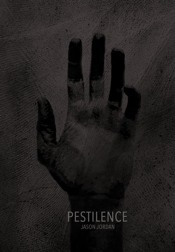 Pestilence
Pestilence
by Jason Jordan
Keyhole Press, 2013
58 Pages / $9.99 Buy from Keyhole Press
Strange situations infect the stories in Jason Jordan’s Pestilence and the unusual premise of each tale blends the surreal with everyday life in a disturbingly enchanting mix. In “Pestilence,” the eponymous story upon which the collection is titled, there is a new plague that visits a building every day of the week. Monday has corpses appearing randomly, then disappearing at midnight. Tuesday has hives of bees that swarm the residents. On Wednesday, they all need scuba gear as the entire building is flooded. The narrator invites a journalist to document the plagues that visit their house. He wants the anomalies within the building to be reported on, yet refrains from personal details about the inhabitants as he’s saving that information for the national media. While the reporter reacts with terror to what he witnesses, the residents are oddly indifferent. After the reporter endures two days of the plagues, he is ready to leave:
The pestilence becomes a decrepit bridge through which the narrator hopes to connect to the world. He is disappointed, then, when he finds out their house is misrepresented in the published article.
In similar form, the characters in the collection attempt to break the quarantine that separates them from everyone else. This is the second book by Jason Jordan I am reading and if there’s an aspect that ties his previous work, The Dying Horse, with Pestilence, it’s a chill attitude by the character in the face of horrors. In the case of “The House of Ice,” that’s a literal chill. The whole house is frozen along with the owner, Bill Jones, his dog, and even the cardinal. There is no explanation given for the freeze and after they are thawed, no one seems to care:
Fears abound but are cast aside in a subdued yearning for change. In the case of “The Pollution Machine,” Christopher is a four-armed worker who runs a complex combustion engine that creates pollution. His extra limbs are explained as the progress of human evolution, potentially caused by the pollution he himself is proliferating. Christopher doesn’t like to be touched by people and even gets a regulation passed that anyone who makes tactile contact with him will be shot. And yet, his instinct is to cut off one of his hands because he doesn’t want to run the machine any longer. In part, this is because he is being persecuted by his co-workers. More importantly, it’s a different type of ‘touch’ he seeks. After leaving the doctor’s office, he rushes to see his mother where the narrator hints at what he really wants: “I hugged my mother with all my arms and said, I don’t want these anymore.”
With the exception of “Ensanguine,” the descriptions are minimalistic and focus on getting the plot across. This amplifies the absurdity of the situations the characters find themselves in and engenders a hopelessness readers of Kafka will be all too familiar with. Understatement is an art here and the normalcy with which the bizarre is treated enunciates the contrasts.
Contrasts are the symptoms of “Rainbow Disease.” Robert is a twelve-year old boy who has “a red head, orange torso, yellow left arm, green right arm, blue left leg, indigo right leg, and violet eyes.” He is trying to get the narrator to donate to the Ridders of the Rainbow or RR. When the narrator refuses, Robert becomes uncomfortably relentless in his attempt to get a donation. The money is trivial. The need for the acknowledgement of his condition and his existence are not. The desire for contact, physical or mental, mar both, even though the narrator admits as he greets Robert good bye: “I want to use his name, but I don’t remember it.”
Jason Jordan’s Pestilence is full of misunderstood characters who want to be touched. Unusual circumstances form a thread throughout the collection and the vaccinating attempts of a miraculous cure are absent. The plague-infested building is the human condition and we are like that rainbow-skinned boy and four-armed pollution machine technician, begging to be heard even at the cost of self-mutilation and humiliation. They understand their diagnosis and the devastating effect the worst plague of them all has. Loneliness, when untreated, is terminal.
***
Peter Tieryas Liu has work forthcoming or published in Gargoyle, the Indiana Review, Menacing Hedge, New Letters, and the New Orleans Review. His novel about Asian Noir and serial killers, The Wingless, is coming out from Signal 8 Press in 2014. You can follow his work at tieryas.wordpress.com and on twitter @TieryasXu.
Tags: Jason Jordan, Pestilence, Peter Tieryas Liu

[…] http://htmlgiant.com/reviews/pestilence-by-jason-jordan/ […]
I’ve been meaning to check this book out. This review’s got me jazzed up about it.
Hey Quincy, it’s a really interesting collection =)
Traiteur Rabat Regal; Traiteur de ronome au Maroc
This is my expert